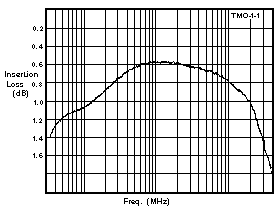
RF Transformers

Essentially, an RF transformer consists of two windings linked by a mutual magnetic field. When one winding, the primary has an ac voltage applied to it, a varying flux is developed; the amplitude of the flux is dependent on the applied voltage and number of turns in the winding. Mutual flux linked to the secondary winding induces a voltage whose amplitude depends on the number of turns in the secondary winding. By designing the number of turns in the primary and secondary windings, any desired step-up or step-down voltage ratio can be realized. Mutual coupling is accomplished simply with an air core but considerably more effective flux linkage is obtained with the use of a core of iron or ferromagnetic material with higher permeability than air.
The relationship between voltage, current, and impedance between the primary and secondary windings of the transformer may be calculated using the following relationships. With reference to Figure 1,

As an example, if Z equals 50 ohms and the turns ratio equals 2, the secondary impedance equals 200 ohms. In this case, the secondary voltage is twice the primary voltage and the secondary current is one-half the primary current.
The basic phase relationship between the RF signals at the transformer input and output ports may be in-phase, 0 degrees, or out-of-phase, 180 degrees. Conventionally, the ports that are in-phase 1 and 3 are marked by dot notation as shown in Figure 2. Ports 1, 4 and 2, 3 are out-of-phase, 180 degrees.

Mini-Circuits' transformers are physically assembled by winding a pair of twisted wires around a ferrite toroidal core. The ends of the primary and secondary wires which leave the same side of the toroid are in the in-phase ports. See Figure 3.

For transformers that have a secondary winding with a center-tap, the schematic representation and dot locations are shown in Figure 4.

In this case ports 1 and 3 are in-phase, 0 degrees, and ports 1 and 6 are out-of-phase, 180 degrees. These transformers may be operated as low as 12.5 ohms at the primary with essentially the same impedance matching ratio and only a slight change in frequency response. For convenience, all Mini-Circuits transformers are specified as a step-up.
For each RF transformer model, the minimum and maximum frequency is given for the insertion loss at the 3 dB, 2 dB and 1 dB points, as shown in Figure 5 and listed in the data chart. For example, the T1-1 insertion loss is 1 dB from 2 to 50 MHz and 3 dB from 0.15 to 400 MHz.

Mini-Circuits offers various transformer package styles for assembly on a printed circuit board. These include:
(1) plastic-case T series, style X65, plug-in leads
(2) plastic-case T series, style W38, flat-pack leads
(3) plastic-case T series, style KK81, surface-mount gull wing leads
(4) metal-case TMO series, plug-in leads
(5) open construction TC series, surface-mount leadless
For these various types, the electrical configurations that are available are:
(A) DC isolated primary and secondary, center-tap secondary
(B) DC isolated primary and secondary, center-tap primary and secondary
(C) DC isolated primary and secondary
(D) unbalanced primary and secondary
(E) DC isolated primary and secondary, balanced primary and unbalanced secondary
(F) DC isolated, three open windings
Coaxial connector models are available from 5 KHz to 500 MHZ and are offered with 50 ohm and 75 ohm impedances; 75 ohm connectors are used at 75 ohm ports. The FT1.5-1, with unbalanced input and output is especially useful for 50 ohm to 75 ohm matching applications. The FTB series with unbalanced output and balanced input (connector ground insulated from the case) helps eliminate ground loop problems, especially when long cable runs are involved.

In some applications there is a need to pass a relatively high DC current through the primary winding. In this case, the transformer core may saturate resulting in reduced transformer bandwidth and power handling capability. Mini-Circuits TH series of transformers are designed to handle up to 100 mA in the primary winding without appreciable saturation and change in RF characteristics.
Transformer core saturation is influenced by (1) DC current through the winding, (2) RF input power, and (3) frequency of operation. These three variables interact to affect the point at which saturation occurs. See Figures 7 and 8 in which conventional transformer saturation is compared to the TH series.
Mini-Circuits has developed many special transformer impedance ratios and configurations where high DC current is passed through one winding of the transformer. Many of these designs have been for open package surface-mount requirements. Consult our Applications Department for your particular needs.

A:
A DC-isolated transformer is one that does not allow a DC current to pass between the primary and secondary windings.Q: Mini-Circuits transformers are tested with 50-ohm systems. How do they perform at other
impedance?
A:
Q: Are Mini-Circuits' transformers step-up or step-down?
A:
Q: Can I just use one side of a center-tapped transformer ?
A:

Q: Can Mini-Circuits supply MIL-tested transformers?
A:
Q: What are the effects of temperature extremes on Mini-Circuits transformers?
A:
As temperature increases, the permeability increases thereby slightly decreasing insertion loss at low frequency. This is true, however, as long as the temperature does not increase above the Curie temperature of the core. Mini-Circuits' designs use cores that have a Curie temperature much higher than the highest specified operating temperature.
Q: Explain the reasons for low-end and high-end losses of a transformer.
A:

The low-end loss is heavily influenced by the primary inductance while the high-end loss is attributed to the interwinding capacitance and series inductance.
Q: How do I measure the insertion loss of a transformer?
A:
Q: Can I build a power splitter with Mini-Circuits' transformers?
A:
The isolation between output ports and the output return loss of each port will not be as good as a Mini-Circuits' standard power splitter.
Q: What are the breakdown voltage ratings of Mini-Circuits' transformers?
A:
Last Updated: 09/08/1999